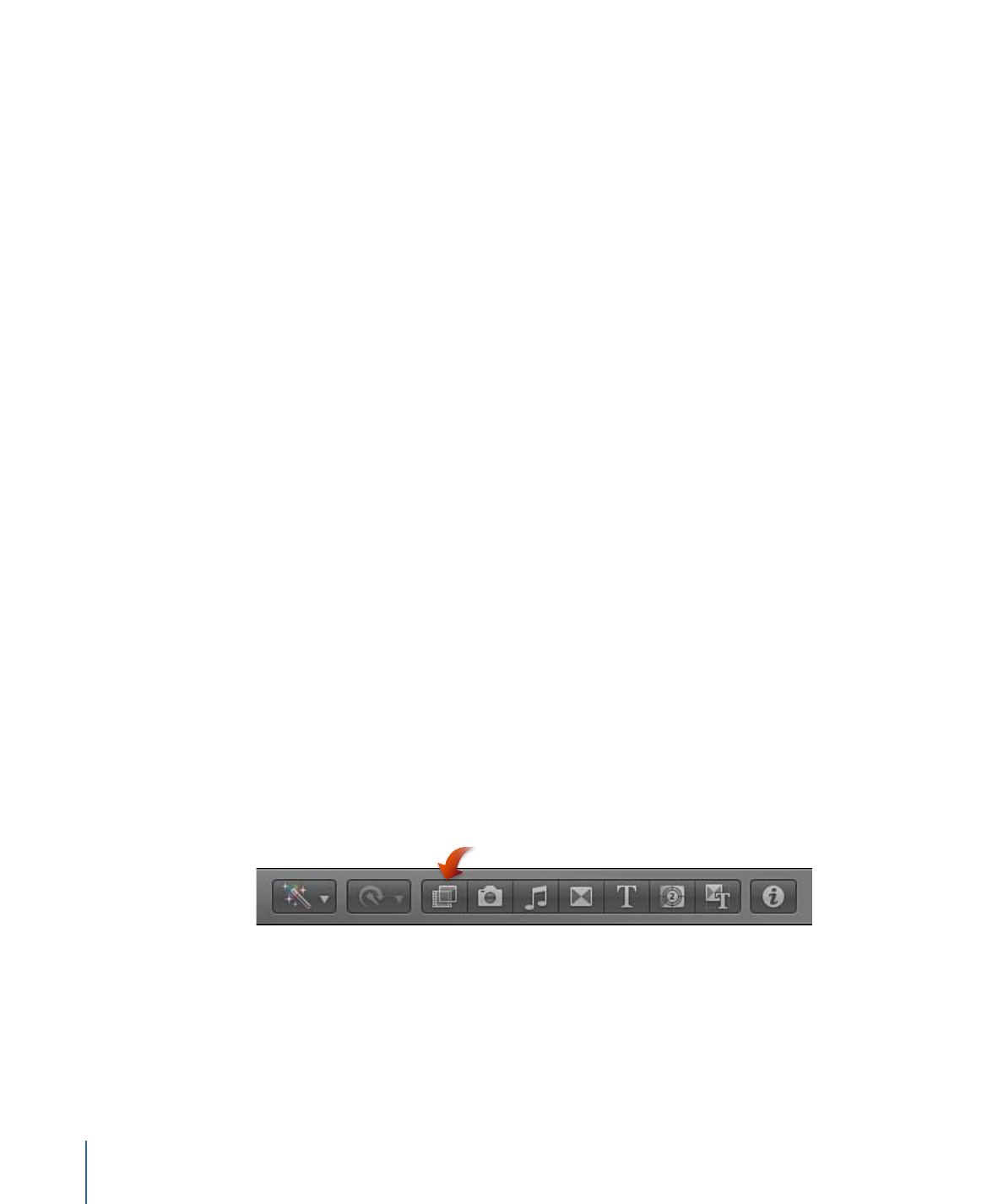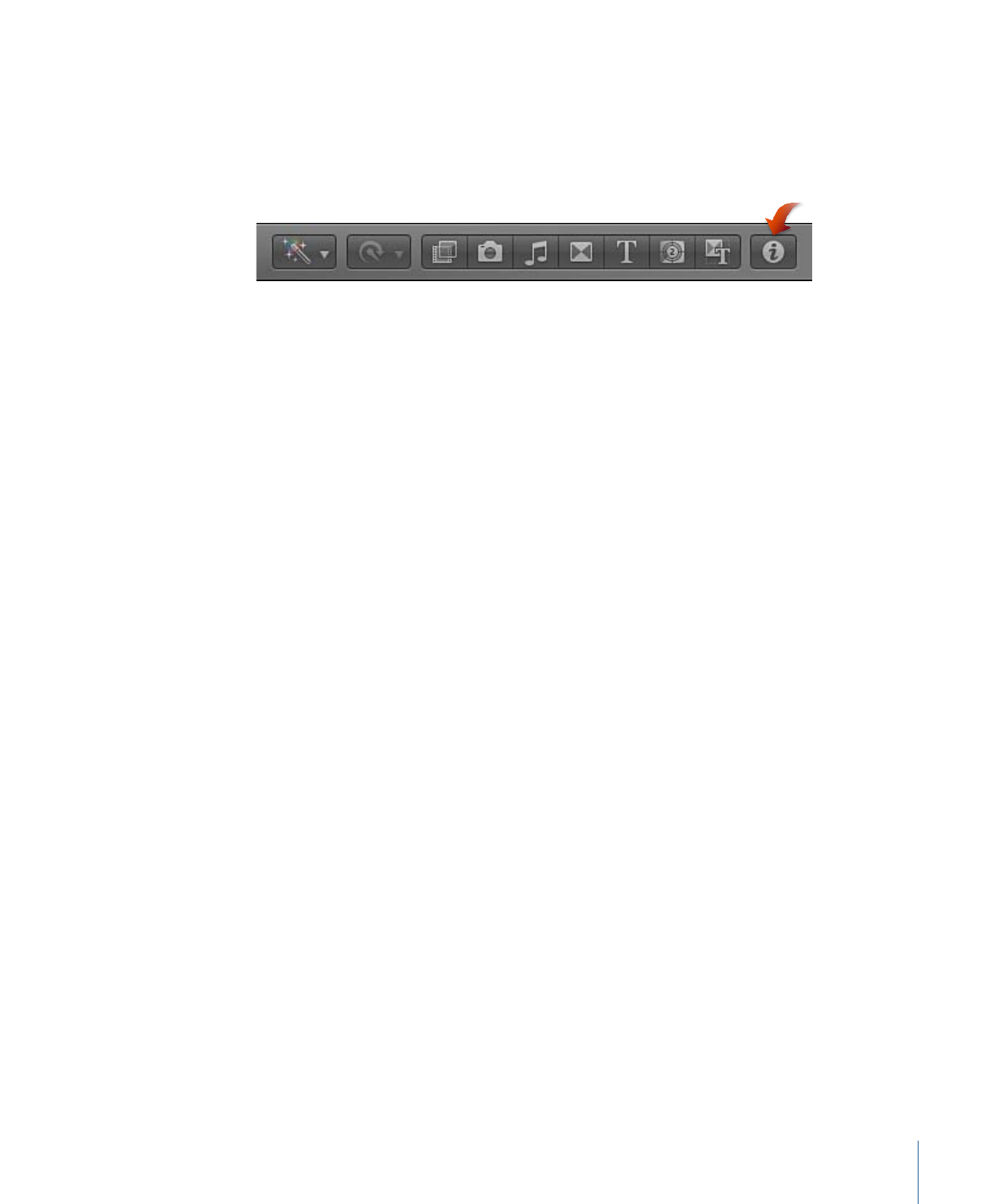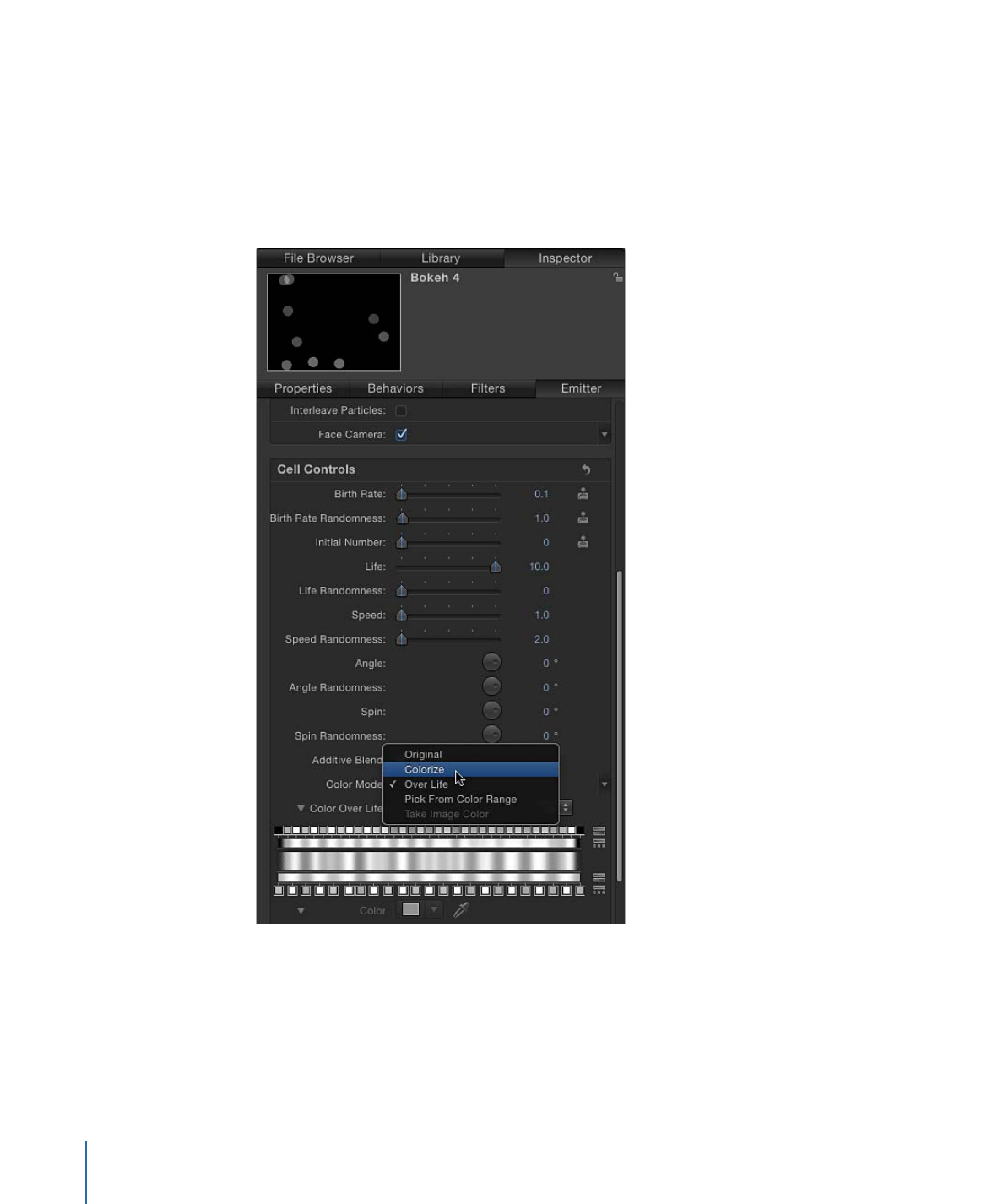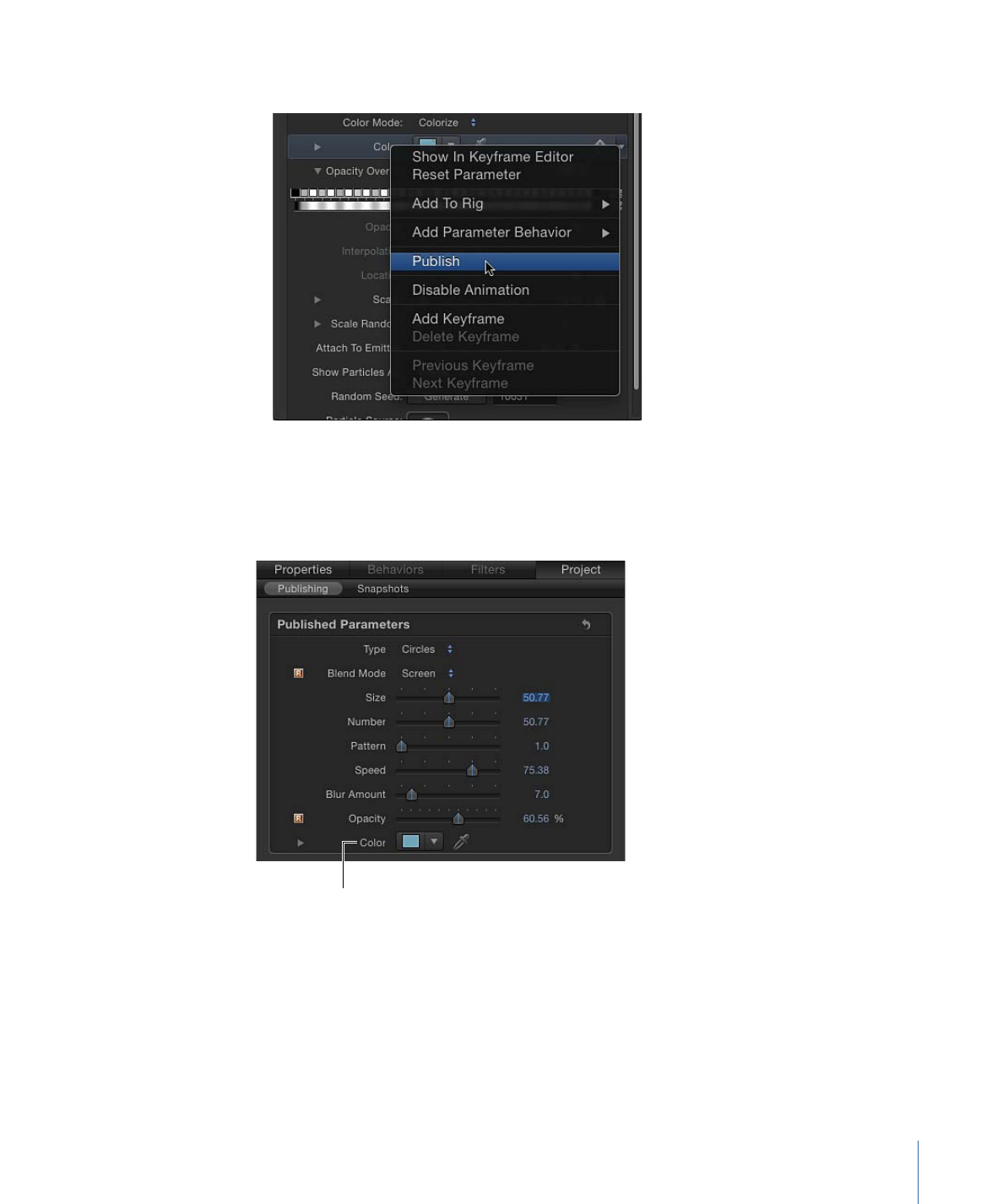
Example: Modifying the Bokeh Random Effect
In Final Cut Pro X, the Bokeh Random effect adds moving, blurred particles to a clip. The
shape, blend mode, speed, and other particle parameters of the effect can be edited in
Final Cut Pro X. Most Final Cut Pro X effects (as well as transitions, titles, and generators)
can be opened and modified in Motion to limit or add parameter controls.
Note: Bokeh comes from the Japanese term “boke,” meaning blur or haze. Bokeh is a
term used in photography to describe the aesthetic quality of a blurred image.
To inspect the Bokeh Random effect in Final Cut Pro X
1
In Final Cut Pro X, select a clip in the Timeline, then click the Effects Browser button in
the toolbar.
2
In the Effects Browser, select the Light category, then move the pointer back and forth
over the Bokeh Random thumbnail.
A preview of the effect plays in the Viewer.
3
To apply the effect to the selected clip, do one of the following:
• Double-click the Bokeh Random effect.
508
Chapter 11
Creating Templates for Final Cut Pro X

• Drag the effect to the clip in the Timeline. When the clip is highlighted and the add
pointer (+) appears, release the mouse.
The Bokeh Random effect is applied to the clip.
4
Click the Inspector button in the toolbar.
The first control in the Inspector is the Type parameter, which sets the shape of particles
in the effect.
5
To change the particle shapes to hexagons, choose Hexagons from the Type pop-up
menu.
6
Adjust some of the other controls, such as Size, Number, and Opacity to see how they
change the effect.
7
Click the Reset button (the curved arrow at the end of the activation checkbox row) to
set the parameters back to their default values.
In the next task, a copy of the Bokeh Random effect is opened and edited in Motion so
that the option to change the shape of the particles is removed from the effect, and the
option to change the color of the particles is added to the effect.
To add a parameter to the Bokeh Random effect’s Final Cut Pro X Inspector
1
In the Final Cut Pro X Effects Browser, Control-click the Bokeh Random effect, then choose
“Open a copy in Motion” from the shortcut menu.
A copy of the template opens in Motion, and the duplicated file appears in the Final Cut Pro
Effects Browser.
2
If necessary, choose Fit in Window from the Zoom Level pop-up menu above the Motion
Canvas.
Optional: To better see the effect you are modifying, drag a still image from the File
Browser to the Canvas, releasing the mouse button when the pointer changes to a curved
arrow and the placeholder is highlighted with a yellow border in the Canvas.
Note: This image is not saved with the Bokeh Random copy to the Final Cut Pro Effects
Browser.
3
In the Layers list, click the Project object, then click Publishing in the Project Inspector.
The controls that are published in the preset Bokeh Random effect are listed: Type, Blend
Mode, Size, Number, Pattern, Speed, Blur Amount, and Opacity. Several of the published
parameters are rig widgets. For detailed information on rigs and widgets, see
Using Rigs
.
When a parameter is published, it becomes available in the Final Cut Pro Inspector. For
detailed information on publishing, see
Publishing Parameters in Templates
.
509
Chapter 11
Creating Templates for Final Cut Pro X

4
In the Layers list, open the Bokeh group, then open the Hexagons and Circles groups.
The effect is comprised of rigged particle parameters, behaviors, and a Gaussian Blur filter.
For an example of rigging, see
Advanced Example: Creating an SLR Effect Template Using
Rigging
.
5
In the Circles group, select the “Bokeh 4” particle emitter, then choose Colorize from the
Color Mode pop-up menu in the Emitter Inspector.
6
Select a new color from the Color parameter.
In the Canvas, the circular particles change to the new color.
7
Do one of the following:
• Click the Color parameter’s Animation menu (the downward triangle that appears when
you place the pointer over the right side of the parameter row), then choose Publish.
510
Chapter 11
Creating Templates for Final Cut Pro X

• Control-click the Color parameter’s name, then choose Publish from the shortcut menu.
8
Click the Project object to view the modified published parameter list.
The Color parameter now appears in the list. When the modified template is applied to
a clip in the Final Cut Pro Timeline, the Color parameter will be available in the Final Cut Pro
Inspector.
Published Color parameter
In the next task, remove the Type parameter from controls that will appear in the
Final Cut Pro Inspector.
To remove a parameter from the Bokeh Random effect’s Final Cut Pro X Inspector
1
In the Publishing pane of the Project Inspector, do one of the following:
• Click the Type parameter’s Animation menu (the downward triangle that appears when
you place the pointer over the right side of the parameter row), then choose Unpublish.
511
Chapter 11
Creating Templates for Final Cut Pro X

• Control-click the Type parameter’s name, then choose Unpublish from the shortcut
menu.
The Type control is removed from the list and will not be available in Final Cut Pro.
2
Choose File > Save (or press Command-S).
If you imported a still placeholder image, a dialog appears asking if you want to copy
that image to the saved Motion project. To save the image with the Motion project, click
Copy. To save the project without the image, Click Don’t Copy. Neither option has any
affect when the template is applied in Final Cut Pro.
Note: To save the effect with a different name or to a different category in the Effects
Browser, choose File > Save As. The initially created file (Bokeh Random Copy) remains
in the Final Cut Pro Effects Browser and Motion Project Browser, but can be deleted from
the folders in /Users/username/Movies/Motion Templates.
The effect is now ready for use in Final Cut Pro. Unlike the original preset, Bokeh Random
Copy includes a control to change the color of the particles, and no longer includes a
control to change the shape of the particles.